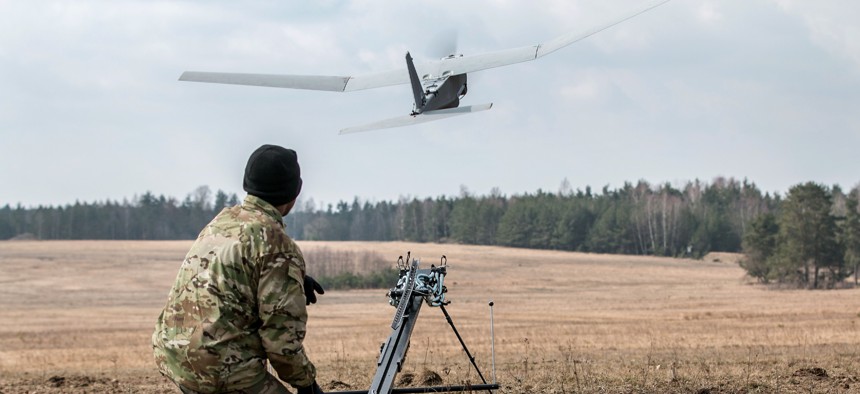
Army Pvt. Jonathan Jackson launches a Puma aviation system during a multinational joint equipment training brief on April 2, 2018, in Grafenwoehr, Germany. The Army is looking to test new Robotic and Autonomous Systems this summer, according to a recent RFI. U.S. Army Photo
Got New Autonomous Tech? The Army Wants to See It
Officials are gathering candidates for a second autonomous-tech assessment: air-ground robots, voice-guided technology, and more.
The Army’s main research laboratory is gearing up for its second autonomous technology assessment event and is searching for targeted capabilities.
The Army’s Combat Capabilities Development Command Army Research Laboratory extended the deadline for its request for information on Tuesday. DEVCOM ARL is seeking a range of autonomy-enabled capabilities to help inform the service’s modernization efforts.
DEVCOM ARL hosted its first Industry Autonomy Technology Assessment at Aberdeen Proving Ground, Maryland, in July 2022. That event focused on testing “ground robotics technologies with capabilities for protecting operating areas, personnel and infrastructure in numerous types of environments and situations” across expeditionary missions.
According to the RFI, which extended submissions until March 8, the focus for the second IATA will be on areas like enhanced mobility, detection and teaming in operational environments.
DEVCOM ARL wants to test technology with capabilities for autonomous mobility, air-ground Robotic and Autonomous Systems teaming, coordinated behaviors of RAS teams, object tracking/identification, global localization, human language-guided operation of RAS and weather-resistant unmanned aircraft systems.
Specifically, officials want to test autonomous mobility technologies that can traverse different environments without a reliance on remote control or teleoperation commands; coordinate multiple air and ground RAS assets; detect, track and classify pedestrians and vehicles in both urban and unstructured environments; enable unmanned vehicles to operate in GPS-denied environments for up 10 kilometers; offer the ability to use natural language commands to RAS systems; and allow small UAS systems to operate in inclement weather and moderate wind.
“The primary objective of these events is to identify and assess technologies that can accelerate solutions relevant to Army modernization priorities,” the RFI said. “Tech Assess ‘23 provides developers the opportunity to examine and understand Army challenges and receive assessment data on how well their technologies addressed the challenges.”
Interested applicants must first submit a white paper of the proposed technology for review. If selected, the applicants must then supply a PowerPoint presentation and associated video for a chance to demonstrate the technology at Tech Assess ’23, which will be held mid-summer at Aberdeen Proving Ground.
The event is one of several efforts the Army has going to gain insight into the autonomous capabilities available on the market, including Maneuver Support & Protection Integration eXperiments, or MSPIX, and the Technology Gateway program.
Interested stakeholders have until 5 p.m. EST on March 8 to apply.



